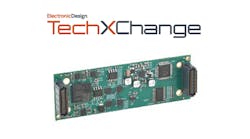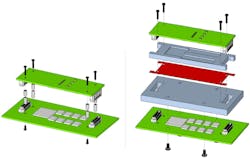Technical Overview of VITA 93 QMC
VITA’s new mezzanine card standard, VITA 93 QMC, targets any rugged or industrial application, not just its usual military and avionic applications. It utilizes Samtec’s AcceleRate HD Ultra-Dense, Slim Body Arrays with a 0.635-mm pitch. This connector is rated up to 64-Gb/s PAM4, making it ideal for high-speed serial interfaces like PCI Express Gen 6 that supports the Compute Express Link (CXL) standard.
Jan Zimmermann, General Manager at TEWS Technologies, gave a short overview at this year’s Embedded Tech Trends conference (watch the video above). You can also check out the details here.
VITA 93 QMC Pins and Signals
VITA 93 QMC modules have two sets of sockets (Fig. 1). One side provides an interface to the host while the other is dedicated to I/O.
The host side provides power (3.3 V and 12 V) along with an I2C interface that supports the Intelligent Platform Management Interface (IPMI). This will also work with the upcoming VITA 100.20 module management system.
There’s a x4 PCI Express (PCIe) interface plus a few additional signals like JTAG. A few pins are unallocated at this point.
>>Check out this TechXchange for similar videos and articles
The I/O side is organized as five I/O pipes with either eight single-ended or four differential I/O signals. Each signal pin has a matching ground connection, which translates to 40 I/O signals per x1 QMC socket.
VITA 93 QMC Module Sizes
Most mezzanine cards or modules come in only one size. An exception is the M.2 standard that defines different length modules. Unfortunately, M.2 has a single screw at one end and an edge connector at the other end.
VITA 93 QMC defines four different size modules, but the scaling is by width rather than length (Fig. 2). This approach has significant advantages—for example, the wider versions provide more I/O pins. The modules retain their rugged mounting, which opens up additional board space.
The scalable modules also provide more flexible connectivity options with carrier boards that have multiple slots. A four-slot carrier board, for instance, can support four x1 modules, two x2, one x1, and one x3 or a x4 module.
Stacking of VITA 93 QMC Modules
VITA 93 QMC modules are designed to fit in cramped locations. The standard clearly defines the space requirements that components on the top and bottom of the module must meet (Fig. 3).
The stacking height is based on the socket on the carrier board. Higher versions allow for more components to be placed under the VITA 93 QMC module. The most compact version is only 9 mm high.
Cooling VITA 93 QMC Modules
VITA 93 QMC modules can be convection- or conduction-cooled (Fig. 4). The latter offers more cooling capability, but it requires added hardware in the stack as well as a matching heatsink or cold plate. The cooling structure design is up to the carrier designer as the module specification prevents odd-sized modules. Thermal interface material (TIM) fits between the module-provided heatsink and the matching carrie- board heatsink.
VITA 93 QMC’s flexible expansion features and tight specifications suit it for industrial and commercial applications, especially those with shock and vibration challenges. Carrier boards can be custom or based on standard board form factors like PCIe and OpenVPX.
>>Check out this TechXchange for similar videos and articles
About the Author
William G. Wong
Senior Content Director - Electronic Design and Microwaves & RF
I am Editor of Electronic Design focusing on embedded, software, and systems. As Senior Content Director, I also manage Microwaves & RF and I work with a great team of editors to provide engineers, programmers, developers and technical managers with interesting and useful articles and videos on a regular basis. Check out our free newsletters to see the latest content.
You can send press releases for new products for possible coverage on the website. I am also interested in receiving contributed articles for publishing on our website. Use our template and send to me along with a signed release form.
Check out my blog, AltEmbedded on Electronic Design, as well as his latest articles on this site that are listed below.
You can visit my social media via these links:
- AltEmbedded on Electronic Design
- Bill Wong on Facebook
- @AltEmbedded on Twitter
- Bill Wong on LinkedIn
I earned a Bachelor of Electrical Engineering at the Georgia Institute of Technology and a Masters in Computer Science from Rutgers University. I still do a bit of programming using everything from C and C++ to Rust and Ada/SPARK. I do a bit of PHP programming for Drupal websites. I have posted a few Drupal modules.
I still get a hand on software and electronic hardware. Some of this can be found on our Kit Close-Up video series. You can also see me on many of our TechXchange Talk videos. I am interested in a range of projects from robotics to artificial intelligence.





